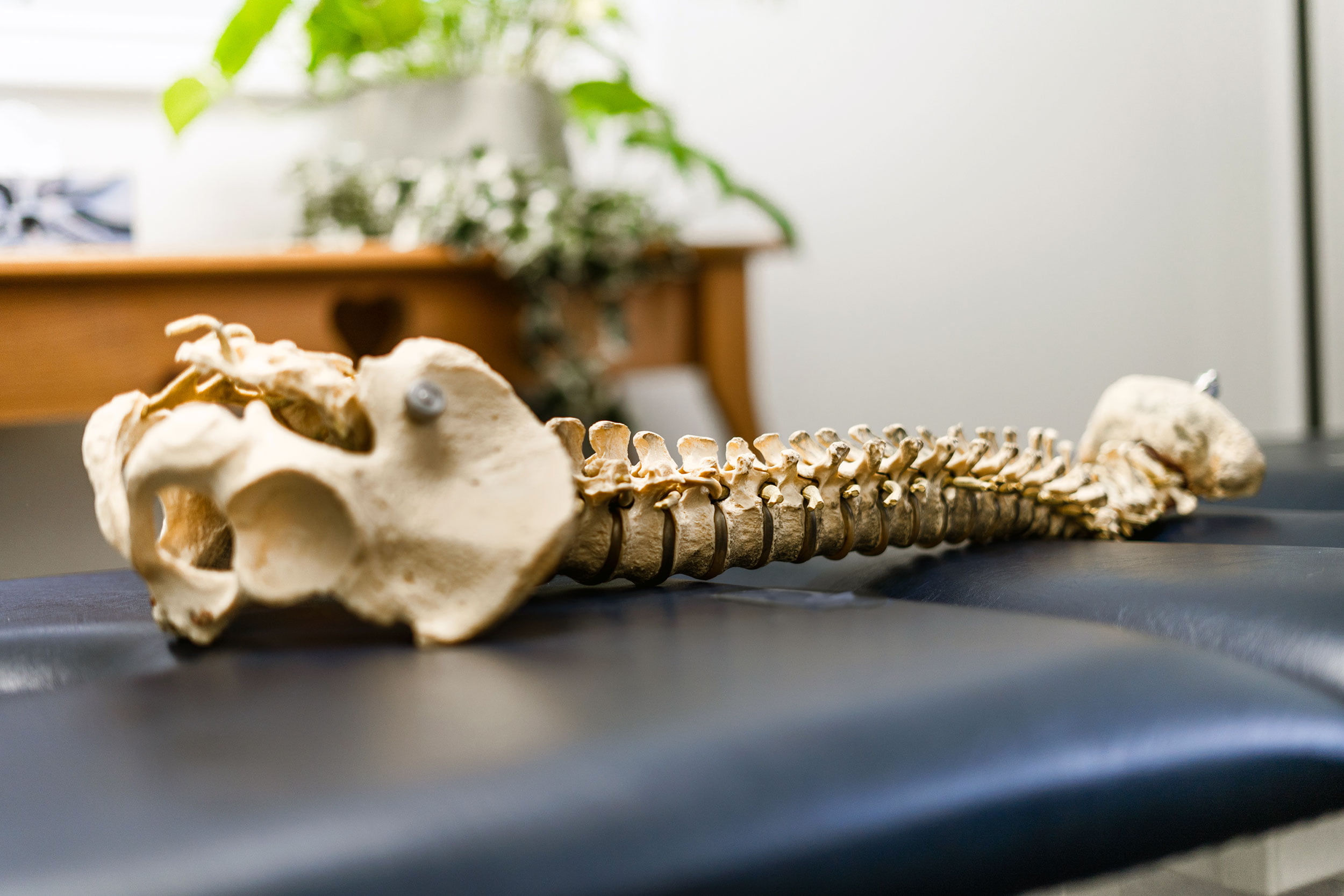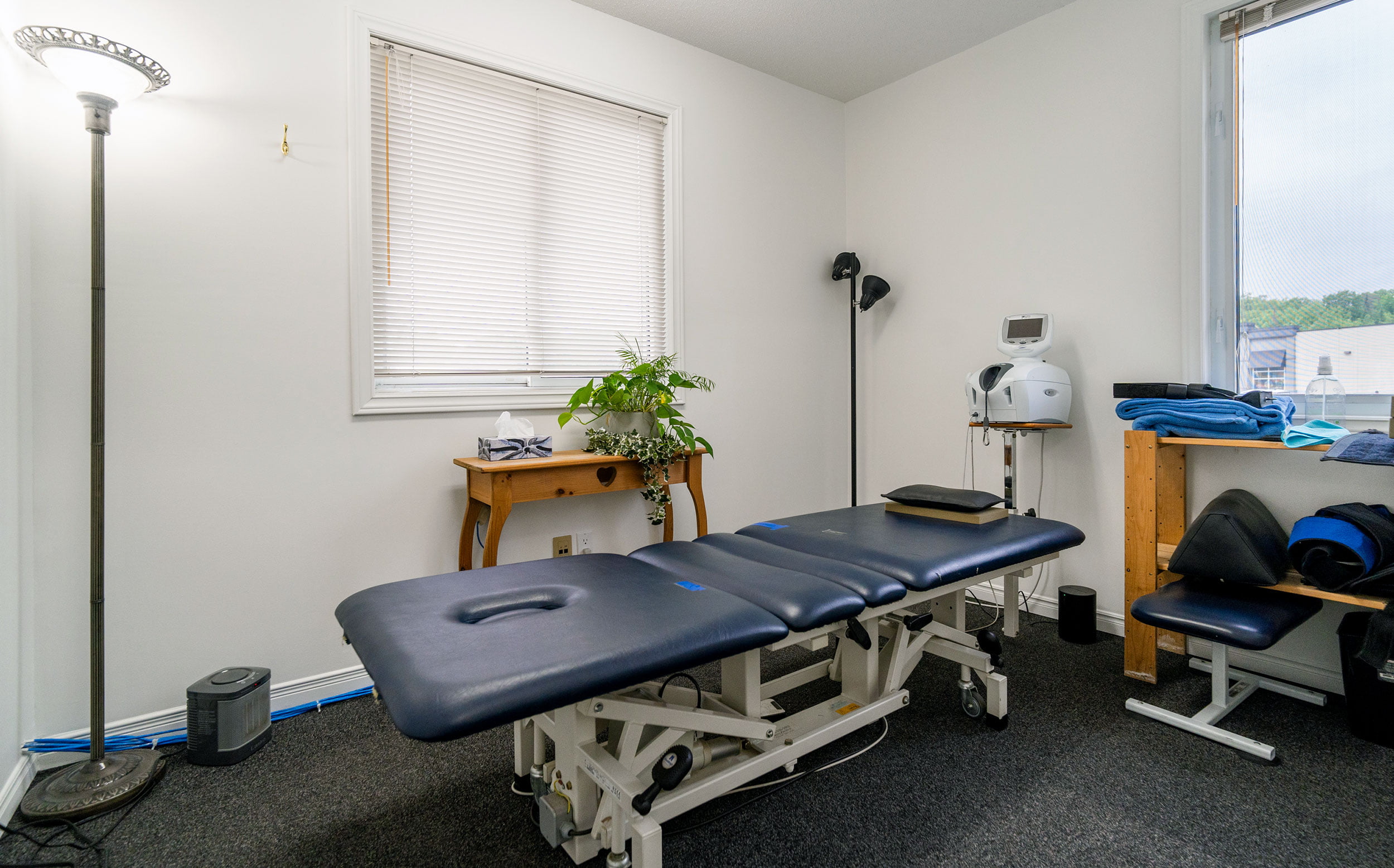Learn more about
Spinal decompression
What is Non-Surgical Spinal Decompression (NSSD)?
Non-Surgical Spinal Decompression is a revolutionary new technology used primarily to treat disc injuries in the neck and in the low back. This treatment option is very safe and utilizes FDA cleared medical equipment to apply axial distraction forces to spinal structures in a precise and graduated manner. Distraction is offset by cycles of partial relaxation. This technique of spinal decompression therapy, that is, unloading due to distraction and positioning, has shown the ability to gently separate the vertebrae from each other, creating a vacuum inside the discs that we are targeting. This ‘vacuum effect’ is also known as negative intra-discal pressure.
The negative pressure may induce the retraction of the herniated or bulging disc into the inside of the disc, and off the nerve root, thecal sac, or both. It happens only microscopically each time, but cumulatively, over four to six weeks, the results are quite dramatic.
The cycles of decompression and partial relaxation, over a series of visits, promote the diffusion of water, oxygen, and nutrient-rich fluids from the outside of the discs to the inside. These nutrients enable the torn and degenerated disc fibers to begin to heal.
For the low back, the patient lies comfortably on his/her back or stomach on the decompression table, with a set of nicely padded straps snug around the waist and another set around the lower chest. For the neck, the patient lies comfortably on his/her back with a pair of soft rubber pads behind the neck. Many patients enjoy the treatment, as it is usually quite comfortable and well tolerated. Many patients even fall asleep during treatment.
Table of Contents
Non-Surgical Spinal Decompression is very effective at treating bulging discs, herniated discs, pinched nerves, sciatica, radiating arm pain, osteoarthritis, degenerative disc disease, leg pain, and facet syndromes. Proper patient screening is imperative and only the best candidates are accepted for care. If you are interested in finding out more information about Non-Surgical Spinal Decompression please call Dr Taylor Martin to schedule your exam. Please bring any x-rays or MRI reports with you.
Understanding Sciatica
The sciatic nerve is a collection of several nerve roots that arise between your lumbar spinal bones (vertebrae). These nerve roots join together and form the largest nerve in the body, the sciatic nerve. This nerve travels down from the low back under the buttock muscles all the way down the legs and feet. Sciatica is a term to describe an irritation or pressure on the nerve, which is commonly caused by a herniated or bulging disc (also referred to as a ruptured disc, pinched nerve, or slipped disc) in the lumbar spine. The pressure or irritation leads to a complex of symptoms that include sharp, radiating pain, burning, and/or numbness and tingling. This is a very debilitating condition that affects thousands of people every year. Dr. Martin will rule out piriformis syndrome which mimics Sciatica during his detailed exam.
Generally, herniated or bulging discs are the cause of the problem. The herniated material of the disc will compress or contact the exiting nerve root producing the symptoms. Sometimes central canal stenosis, lateral canal stenosis, spondylolithesis, or degenerative disc disease can cause this nerve compression as well. The problem is often diagnosed as a ‘radiculopathy’, meaning that one or more intervertebral discs have herniated or protruded from its normal position in the vertebral column and is putting pressure on the nerve root in the lower back, which forms part of the sciatic nerve. Sciatica occurs most frequently in people between 30 and 50 years of age. On many occasions this condition slowly develops as a result of general wear and tear on the structures of the lower spine and discs. Rarely is this condition surgical. Unless there is a progressive neurological deficit, or cauda equina syndrome, the majority of people who experience sciatica get pain relief with non-surgical treatments. Non-Surgical Spinal Decompression is very effective for these conditions. Physical therapy and Chiropractic can help sometimes as well. You may be a candidate if you have tried cortisone shots, nerve blocks, physical therapy, and chiropractic and had little relief, but are still holding off on spinal surgery.
Frequently Asked Questions
How does Spinal Decompression work?
The pumping action described below does two amazing things:
1. As the Spinal Decompression table pulls on your spine, it gently separates the vertebrae from each other, creating a vacuum inside the discs that we are targeting. This vacuum begins to suck the bulges or herniations back into the inside of the disc, and off of your nerve root. It happens only microscopically each time, but cumulatively the results are quite dramatic.
2. Also, this pumping action pumps nutrient-rich fluids from the outside of the discs to the inside. These nutrients enable the torn and degenerated disc fibers to begin to heal back up.Only a few years ago, it was thought that once a disc was degenerated, there was nothing you could do. Now we routinely see discs gain one to two millimeters of sustained increased disc height. While this may not seem like much, it can make all the difference in the world for your nerves.
Does Spinal Decompression work for all spinal conditions?
No. But it is effective in most cases we accept in our office. We’ve treated many cases, some of these patients had both neck and low back pain.
Is there any research on the effectiveness of Non-Surgical Spinal Decompression?
Absolutely! There are many tables that perform non-surgical decompression of the spine.
The following results were obtained from spinal decompression therapy:
- Studies on spinal decompression indicated between a 71-90% success rate with one study reporting an immediate resolution of symptoms in 86% of the participants involved.
How long does it take?
Every patient is different and has a treatment plan tailored specifically to his or her condition. In general, the total treatment ranges from 6 weeks to four months and may include from 20 to 35 visits, more frequently in the beginning and tapering off as your spine begins to stabilize. Most patients respond in 20 visits, however it depends on the severity and chronicity of your condition.
Usually you will be in the office for about 30 minutes, though cases which involve both neck and low back, or which require rehab exercises or other therapies, may have you in here for up to an hour. We also have a fabulous massage therapist, so you may choose to schedule an extra 30 minutes or an hour with him on some of your visits.
Typical Results
Dramatic improvements:
- Sciatica (pain radiating down one or both legs)
- Radiating neck pain (typically down one or both arms, into the chest, and/or into the upper and middle back
Very good improvements:
- Arthritis
- Headaches
- Chronic neck pain
- Chronic low back pain
Tough cases with 20-50% improvement:
- Spinal stenosis caused by significant bone spurring
Clinical Trials
In a recent journal article in Orthopedic Technology Review titled “Surgical Alternatives: Spinal Decompression,” results showed that 86% of the 219 patients who completed the therapy reported immediate resolution of symptoms while 84% of patients remained pain-free 90 days post-treatment. Physical examination findings showed improvement in 92% of the 219 patients and remained intact in 89% of these patients 90 days after treatment.
Another article in the Journal of Neurological Research reported that vertebral axial
“[spinal] decompression was successful in 71% of the 778 cases. The success rate varied from 73% for patients with a single herniated disc. It was 72% for people with multiple herniated discs.”
The American Journal of Pain Management reported “good to excellent” relief in 86% of patients with herniated discs, with back pain and sciatica symptoms being relieved. Good to excellent results were also obtained in 75% of those with facet syndrome.
A small non-randomized study in Anaesthesiology News reported of the 23 patients who responded to therapy, 52% had a pain level of zero, 91% were able to resume their normal daily activities, and 87% were either working or were retired without having back pain as the cause of retirement.
In a small study to determine the long-term effects of vertebral axial decompression, the following results were obtained:
- Among 23 patients, 71% showed more than 50% reduction in pain immediately after treatment, and 86% showed a 50% or better pain reduction at four years.
- After four years, 52% of respondents reported a pain level of zero.
Thus, pain relief not only improved but lasted. This pilot study shows great promise for long term relief and new pain management techniques.
An interesting study at the Rio Grande Hospital, Department of Neurosurgery compared the effects of 20 treatment sessions vs. 10 treatment sessions on chronic low back pain sufferers. The group receiving 20 treatments of decompression therapy reported 76.5% with complete remission and 19.6% with partial remission of pain and disability.
The second group, receiving 10 treatments of decompression therapy, reported a 42.9% rate of remission and 24.1% with partial remission. The failure rate was only 3.9% for those receiving 20 treatment sessions while it was 32.9% for those receiving only 10 sessions. Remission was defined as 90% or greater relief of pain, back to work without limitations, and ability to carry out Activities of Daily Living (ADL’s). Partial remission was defined as the persistence of some pain but the ability to carry out most ADL’s and return to work with some restriction of duties, depending on the occupation. The failure rate was defined as no change in the level of pain and or/ADL.
As you can see from the above-referenced Clinical Trials, Spinal Decompression Therapy may be the only effective therapy for some people experiencing Discogenic or Arthritic pain (pain arising from the disc or caused by various types of Spinal Arthritis). In addition, promising research suggests that the effects of Spinal Decompression Therapy can be a long-lasting solution to certain chronic back pain disorders. Although failure rates are relatively low, studies suggest that completion of prescribed treatments can reduce failure rates from 32.9% to 3.9%.
Contraindications to Spinal Decompression:
- Metallic spinal implants (bolts, plates, screws)
- Fresh disc surgery (less than 6 mos)
- Severe bony stenosis
- Severe osteoporosis
- Grade II or greater spondylolisthesis
- Cancer or tumors of the spine
- Infection of the spine
- Pregnancy
- Aortic aneurysm repair
- Inability to lie flat
Conditions Treatable with Spinal Decompression:
- Herniated disc
- Degenerative disc disease
- Osteoarthritis
- Bulging discs
- Slipped disc
- Ruptured disc
- Sciatica
- Spinal stenosis
- Facet syndrome
- Chronic lower back pain
- Arm and leg pain
- Failed back surgery (without metal implants)
- Compression fractures.


